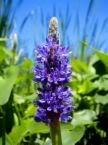

Scientific Name
Pontederia cordata
Uses of Pickerelweed: Landscaping, Medicinal, Culinary, etc...
Pickerelweed forms large colonies along shallow shorelines. The emergent mass of stems and leaves provide wave-buffering protection. Although slow to spread, the root base of this plant thoroughly covers the sediments with a tough vegetative mat. The seed of pickerelweed is eaten by waterfowl. Geese and muskrats will consume the vegetation, while only fish, and to a lesser extent birds and small mammals, utilize flooded foliage for cover. This species is also used extensively in water gardening, due to its showy violet to blue flowers.
General Characteristics
Pontederia cordata is a stout perennial herbaceous emergent that can reach four feet tall. The light green stems and leaves emerge annually from a thick pad of fibrous roots. These roots give rise to short creeping rhizomes, allowing the plant to spread. The waxy leaves develop at the ends of stems, and are highly variable in shape and size. Their shape will range from oval to lance-like, with size varying 2 to 10 inches long and 1/2 to 6 inches wide. Leaf veins are orientated in a parallel arrangement starting at the base.
The compound, violet to blue flowers emerge from an erect spike. The spike will grow to 6 inches in length. The showy flowers appear anywhere from May to October over much of its range. The corky fruit produced by these flowers is oblong and one seeded.
Required Growing Conditions
The natural distribution of pickerelweed is from Nova Scotia to Minnesota, south to Florida and Texas. This plant is typically found growing in the unconsolidated sediments of marshes, streams, shallow lakes, and ponds. It tolerates low fertility and partial sunlight and temporary inundation to 20 inches, but flourishes in fully exposed fertile soils (pH: 6.0 to 8.0), and permanently inundated up to 12 inches deep in freshwater (<3>
Cultivation and Care
In the wild, pickerelweed is predominantly established from seed; there are approximately 5,000 cleaned seeds per pound. The seeds are dispersed by wind, water, and animals to favorable moist unconsolidated sites, where they establish. Similar processes can be mimicked by humans on-site, in nursery beds or greenhouses. Cool moist stratification of the seed is necessary to trigger adequate germination of spring seedings. Utilizing a seeding rate of 20-30 live seeds per square foot will result in the best establishment and development of a stand.Although vegetative dispersal is less frequent in nature, scale-like root corms are located near the soil surface or sometimes exposed and easily separate from the parent plant. When harvested these corms can be planted as bare-foot stock or containerized transplants. Bare-rooted material is typically small and manageable enough to plant using standard hand tools (spade, dibble, planting bar, etc.)
General Upkeep and Control
Once established, it is very important to maintain water depths greater then saturation, but shallower than the leaves year round. Maintaining site hydrology within this range will improve survival over winter. Pickerelweed responds well to the addition of commercial or organic fertilizers. The vegetative portions of this species are seldom damaged by insects, diseases, birds, or mammals. The seeds are often preyed upon by waterfowl.
Tightly spaced clonal populations of this species often co-exist with other shoreline inhabitors. Once pickerelweed has become established, seldom will these other species of emergent vegetation grown within the perimeter of the pickerelweed clones.
Cultivars, Improved, and Selected Materials (and area of origin) No known varieties are available, but wetland nurseries carry local and regional ecotypes.





0 comments: